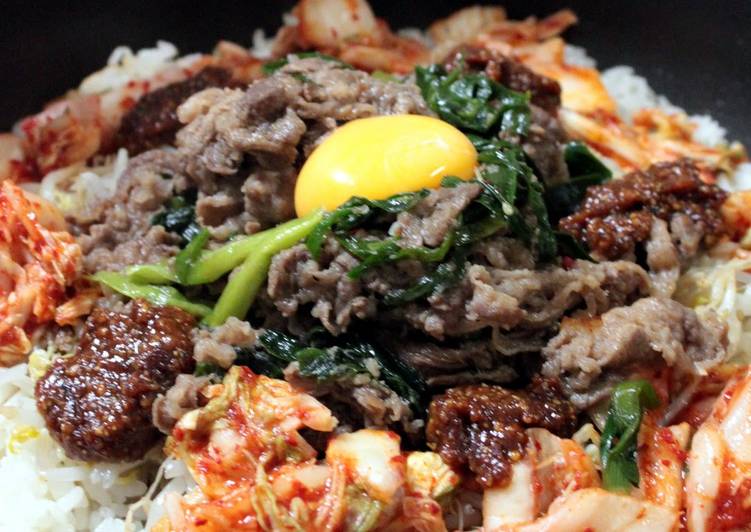Stone-Cooked Style Bulgogi and Bibimbap. Great recipe for Stone-Cooked Style Bulgogi and Bibimbap. This is easier than dividing bibimbap into individual bowls plus it's fun and looks extravagant. And best of all, you can enjoy the piping hot crunchy bits of rice that have been crisped by the pan.
 This is the easiest way to cook a Bibimbap with Chicken Bulgogi.
Bulgogi is the cooking technique where meat is marinated, and cooked on a grill.
Authentic Korean bibimbap recipes use beef bulgogi, but this recipe features chicken slices instead.
You can have Stone-Cooked Style Bulgogi and Bibimbap using 22 ingredients and 10 steps. Here is how you cook it.
This is the easiest way to cook a Bibimbap with Chicken Bulgogi.
Bulgogi is the cooking technique where meat is marinated, and cooked on a grill.
Authentic Korean bibimbap recipes use beef bulgogi, but this recipe features chicken slices instead.
You can have Stone-Cooked Style Bulgogi and Bibimbap using 22 ingredients and 10 steps. Here is how you cook it.
Ingredients of Stone-Cooked Style Bulgogi and Bibimbap
- You need 500 grams of of beef Plain cooked rice plus beef for 4 people (kalbi, chuck, offcuts, etc.).
- You need 1 of enough for all Bok choy, carrot, bell pepper or whatever vegetables you have on hand.
- Prepare 1 bag of Bean sprouts.
- It's 1 of Kimchi.
- You need 2 of to 3 Egg yolks if you have them.
- Prepare 1 of Sesame oil.
- You need 1 of Gochujang (as topping).
- It's of Namul Seasoning - Example: for one bunch of bok choy.
- It's 1 of swirl Sesame oil.
- It's 3 pinch of Salt.
- Prepare 3 pinch of plus Sugar.
- You need 1 of generous amount Toasted sesame seeds.
- You need of Bulgogi Marinade for 500 g of beef:.
- It's 50 ml of Soy sauce.
- Prepare 1/2 tbsp of Grated garlic.
- You need 1 tbsp of Mirin.
- You need 1 tbsp of Sugar.
- You need 1 tbsp of Honey.
- Prepare 1 tbsp of Gochujang.
- Prepare 1 tbsp of Grated kiwi, apple or nashi pear.
- It's 1 tbsp of Grated onion.
- Prepare 1 tbsp of Toasted sesame seeds.
You can use any vegetable that can be sauteed for this delicacy. Top assorted salad ingredients and cooked bulgogi on top of the rice. Drizzle ½ tbsp sesame oil over the ingredients. Serve bibimbap with gochujang sauce (Korean chilli sauce).
Stone-Cooked Style Bulgogi and Bibimbap instructions
- Make the bulgogi: Mix the marinade ingredients together, and marinate the beef in it for at least an hour. Drain off the marinade, stir fry it and transfer to a container..
- Make the namul: Blanch spinach in a pot of boiling water for about 10 seconds, then refresh in cold water. Squeeze out tightly, cut up into easy to eat pieces and mix with the namul seasoning ingredients..
- Sprinkle on the salt and sugar 3 times, drizzle on the oil, then taste and adjust. Blanch the bean sprouts in the same boiling water too..
- Flavor the bean sprouts in the same way. Drain, and mix in the flavoring ingredients while still hot. Add more salt and sugar than you did for the spinach..
- Heat up 2 tablespoons of oil in a frying pan over medium heat. Spread the rice evenly over the bottom. (Don't move the rice around after it's spread on the bottom of the pan!).
- Top the rice with namul, bulgogi and kimchi. The meat will sizzle..
- Lift up the rice with a spatula and look at the bottom. If the rice grains have started to become transparent, drizzle some sesame oil right on the bottom of the pan, and raise the heat to high for a minute to burn the rice a bit..
- When the bottom of the rice is making crackling and popping sounds it's done. Drop an egg yolk in the middle, and bring the frying pan right to the dinner table! Each portion tops their portion with gochujang to taste..
- Mix up from the bottom to eat. The more you mix, the better it tastes! Mix in some gochujang to taste..
- You can use the same marinade to make a 'bulgogi hot pot'. Use a sukiyaki pan for this. Have the beer on ice!.
Bibimbap can be eaten cold or hot. I personally like the veggies cold, so I prepare them ahead of time and keep them in the fridge. When dinnertime rolls around, all I have to worry about is the meat and the rice. Note: Be sure you have your rice cooked and ready. Add the beef and toss to coat.